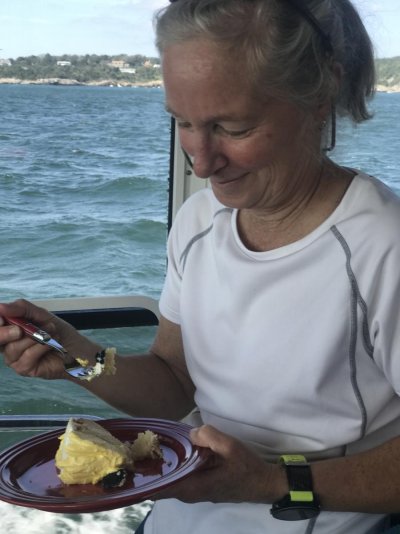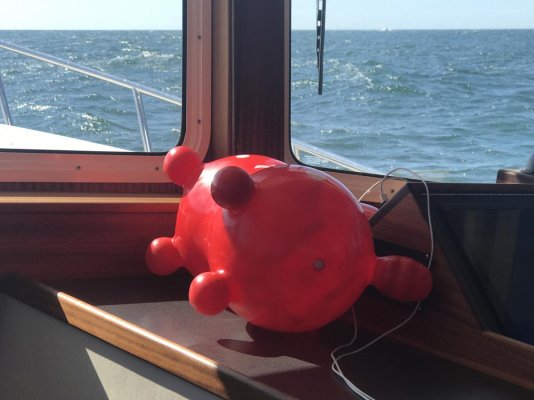Looks great you guys.
What direction were the waves going compared to you? Were the waves coming from the stern as well? How was your speed compared to the speed of the waves?
I have NO experience with that kind of sea state. I never see anything as high as 6-9 feet and never see a period that long.
OK, I’ll elaborate a little in the conditions here.
We had been suffering through a hot, humid air mass all week, with near-record highs in the high 80s with 100% humidity and dense fog. Hurricane Maria had been churning up the coast, driving up tropical moisture and large ocean swells. As of yesterday morning Maria was maybe 300 miles south of us, with Max sustained winds of 70 and TS force winds extending ~230 miles from the center.
Yesterday morning a cold front came through, clearing out the muggy air mass and driving Maria off to the east and bringing with it a building post-frontal northerly.
The marine weather forecast for the day, for our trip area (Rhode Island Sound/Block Island Sound), was for 15 kt northerlies gusting to 25, 6-9 foot swells, and a small craft advisory for seas.
So why did we make the decision to go? First, of course, we wanted a little fall excursion on the boat. Second, the forecast was generally good. Third, although there was the forecast for 6-9 ft seas, I knew they would be “old” seas with a long period, and there would be no new surface wind from the same direction (SSE) to kick them up. The forecast northerly was too new to cause any real mess, and was coming off the land with little fetch except for the approach to Block Island. There were several bail-out points along the route. Finally, we sort of wanted to see how the boat would behave in fairly large rollers in otherwise benign conditions. Also, the seas would be mostly somewhere on our port bow, which I considered optimal from a running comfort perspective.
The wind was exactly as forecast, but only gusting into the 20s for short periods of time. The sea state I’ll discuss later.
Our itinerary was a 30-mile run and started in upper Narragansett Bay, totally protected from any ocean influence, where we ran south dead downwind in generally flat water with 1-2 foot wind-driven surface chop for about 10 miles.
When we got to the entrance of the Bay between Beavertail (Jamestown) and Castle Hill (Newport) we began to feel the swell. This was open ocean, with no land mass between us and the Tropical Storm. From here our course was generally SSW towards Point Judith and Block Island. We could see impressive breakers on all the exposed shorelines and headlands, especially Brenton Point and Beavertail, both of which were shrouded in salt mist from the surf. In the last five days there had been at least three coast guard rescues of tourists swept off rocks by breaking seas.
The swell built gradually as we made our way away from the bay entrance. It settled in at what I guessed was generally a six-foot swell with a long period. I started checking real-time buoy reports, and those nearest to our course were reporting 13’ seas at 12 sec (Nantucket buoy, about 70 miles SE of us), 9’ seas 12 sec (Montauk Buoy, about 50 miles SW) and 9’ seas 12 sec (Long Island Bouy, about 80 miles SW). (These distances are rough estimates - I did not measure.)
As we proceeded SW, the swell became a little more consistent and occasional large rollers appeared in the mix. They were coming in at about 45 degrees off the port bow and were very long period. The northerly was pushing our tail but the surface (wind) waves were insignificant, especially as we were running downwind. The surface waves had no impact on the southerly swells.
We were running at about 2000 rpm at 9.5 knots. The boat was VERY comfortable, rolling up and over the seas with a nice motion, doing an occasional sashay as she transitioned in the troughs.
The normal straight-line course to Block Island runs close inshore to the Point Judith, which even on a calm summer day can be uncomfortable from a confusion of tide and wind an ocean influence. As you approach the point the bottom comes up from about 90 feet to 30-40 feet. I set our course to stay about a mile and a half out, where the bottom gets as close as 50 feet. It was in this area we saw the largest and most consistent seas. They were definitely lining up in their approach to shore and pushing up higher. I would put them at a solid 7-9 feet, with the occasional “big one” that was, what, 11 feet? We were losing the horizon on a regular basis.
I’m always cautious when I estimate seas. I think everyone tends to overestimate. I have done a fair amount of offshore sailing, including two trans-Atlantic, one Pacific from Panama to New Zealand, and countless runs between New England, Bermuda and the Caribbean. I’ve seen some pretty nasty stuff so I try to put it all in perspective.
Cameras, photos and video always flatten things out, so it’s impossible to show true conditions. Having said that, I will post one clip I took as we came around Point Judith. As we came over the top of a “big one” we took a roll and I lost the phone so it missed the best of the sea, but it gives a better idea. (And in case anyone is concerned, even Rody stood firm on this roller, even if he capsized later on in the trip when we had to turn broadside for a bit.)
The bottom line here is that I do believe we were seeing six to nine foot seas, with a few that were larger than that. Conditions were in no way dangerous for this boat. We would not have gone out if I had thought they were at all dangerous. Because of the age of the seas, the long period and the otherwise spectacularly beautiful conditions, it was simply a good opportunity to get out there and experience something a little different. We would have zero interest in heading out in 6-9 foot seas with a 6 second period and the associated storm wind that drives them, so please don’t try to equate the two situations.
<iframe width="560" height="315" src="
" frameborder="0" allowfullscreen></iframe>




